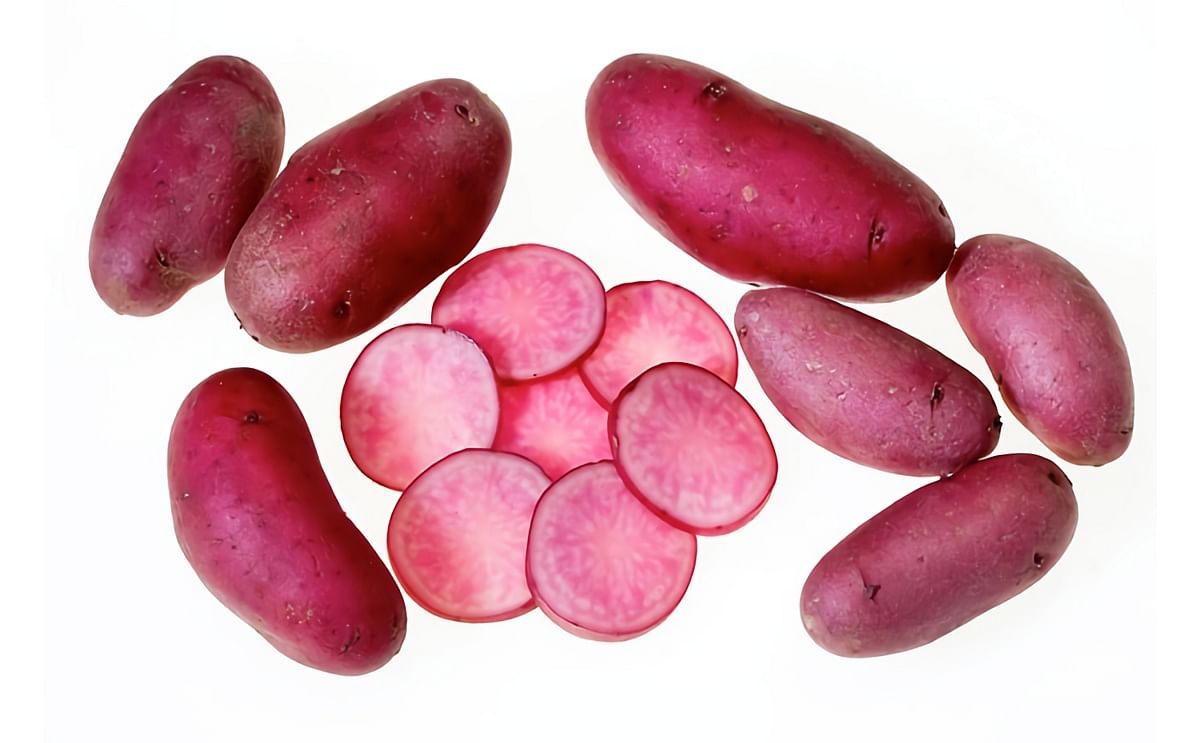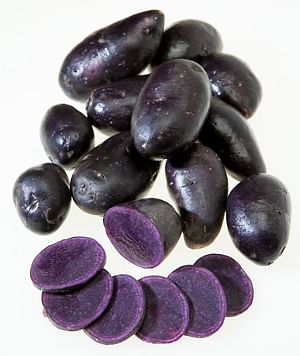The potato variety Amarosa
New Specialty potatoes: Delicious, Nutritious and Colorful

America’s favorite vegetable is almost fat free and a good source of potassium, iron, and vitamin C. It has 3 grams each of protein and fiber, low sodium, and no cholesterol, and costs a quarter per serving at the produce aisle.
If you haven’t guessed which vegetable yet, it’s only going to get harder. Agricultural Research Service scientists have bred and released colorful new varieties. Some have relatively high levels of beneficial red-to-purple pigments called “anthocyanins,” and others have high levels of yellow-pigmented carotenoids.
We’re talking about the popular potato. ARS researchers have developed three new varieties of potatoes with red and purple flesh and skin, which are now available to consumers. If you can get the new varieties soon, you’ll have colorful potatoes gracing your holiday dinner table. See below for information on availability.
What’s In a Color?
All potatoes contain an assortment of nutrients and other health-promoting compounds. The colored-flesh potatoes have anthocyanins and carotenoids. The amount and type depend on the variety of the potato. Breeding efforts by ARS researchers in Beltsville, Maryland, led to the release of yellow-pigmented potatoes with up to three times more carotenoids than a yellow-fleshed imported variety.
As the most-eaten U.S. vegetable, phytonutrient-rich potatoes can have a strong impact on health, according to plant geneticist Charles Brown, who is with ARS in Prosser, Washington. In a study, Brown and his colleagues analyzed and compared concentrations of phytochemicals in yellow- and purple-pigmented potatoes and in white potatoes. The team reported that yellow potatoes had a 45-fold greater concentration of carotenoids than white potatoes, and purple potatoes had a 20-fold greater concentration of anthocyanins than yellow potatoes. No detectable amounts of anthocyanins were found in white potatoes.
During the same study, the team also compared sensory evaluations of pigmented potatoes to those of white potatoes. When yellow, purple, and white potatoes were ranked by a consumer panel, no significant differences in flavor or overall acceptance were observed. The study was published in Food and Nutrition Sciences in 2013.
Coming to the Table
Brown carefully bred the three unique red- and purple-pigmented potatoes at ARS’s Vegetable and Forage Crops Production Research Unit in Prosser.
“Getting them to consumers has taken decades,” says Brown. “The cost in labor alone to bring a new variety to market is considerable.” The steps to market included selections, crosses, evaluations, and extensive field-testing around the nation. Growers, buyers, and industry representatives make further postharvest evaluations based on consumer-acceptability features prior to release.
The three great-tasting potato varieties with colored flesh that are now available for consumption are TerraRosa, AmaRosa, and Purple Fiesta (also known as Purple Pelisse).
They perform well across a variety of preparation methods such as baking, roasting, microwaving, steaming, and mashing.
AmaRosa is a “fingerling” (long and thin) specialty potato with smooth, vibrant, red skin and bright-red flesh. TerraRosa, described by growers as sweet and creamy, is a full-sized, oblong variety with red skin and pinkish flesh that sometimes has white marbling inside.
Purple Fiesta is a small, smooth fingerling with purple skin and dark-purple flesh. “Purple Fiesta has ranked better in taste, color, and nutrition than any other blue or purple potato I’ve explored,” says Dan Chin, who holds the exclusive license to grow and sublicense seed. “These varieties were carefully bred to enhance all the unique qualities found in a colorful potato, including uniform size, striking color, rich vitamin and mineral content, sweet flavor, and versatility.”
Brown worked on developing and evaluating the varieties as a contributing partner with the Northwest (Tri State) Potato Variety Development Program—a team that includes university researchers in Washington, Idaho, and Oregon; commissioners of the three states; and the potato industry. The Tri State Program created the Potato Variety Management Institute, a nonprofit based in Bend, Oregon, that administers licensing agreements for new varieties.
All three potatoes have ranked well for use in making potato chips and fries. “One of the sensory evaluations ranked AmaRosa highest among 10 contenders when prepared as fried chips,” says Brown. “The chips retained their rosy red color and resisted fading, showing great potential for the chipping snack sector as well.”
Articles describing the attributes of AmaRosa and Purple Fiesta were published in the American Journal of Potato Research in 2012.
The Power of Pigments
While the new potato varieties are festively colored and taste good, their value is far from skin deep. Foods rich in antioxidative bioactive compounds have been linked to reduced incidence of chronic diseases. So Brown and geneticist Duroy (Roy) Navarre, who is also at the ARS Prosser laboratory, worked with lead author Boon Chew and colleagues at Washington State University on a human nutrition study. They tested whether the carotenoids and anthocyanins from pigmented potatoes decreased oxidative stress, inflammation, and improved immune status. Their study was based on USDA-ARS colored-potato breeding lines developed at Prosser.
For the study, 36 healthy male volunteers were randomly assigned to consume white-, yellow-, or purple-fleshed potatoes for 6 weeks. Every day, the three groups (12 volunteers each) consumed two-thirds of a cup (150 grams) of the type of cooked potatoes assigned to them. All the potatoes were prepared and served at the research site.
Fasting blood samples were collected from the participants at the start and end of the 6-week intervention. Their blood was tested for cytokines, including interleukin-6, which is secreted by lymphocytes (immune system white blood cells), while initiating an inflammatory response. Blood samples were also tested for lymphocyte proliferation, C-reactive protein (another biomarker of inflammation), and phenotype.
The researchers found that the participants who were fed the carotenoid-rich yellow potatoes and anthocyanin-rich purple potatoes had lower plasma IL-6 than those fed white potatoes. Volunteers consuming the purple potatoes showed a heart-healthy decrease in C-reactive protein from the study’s start. And those who ate the yellow-pigmented potatoes showed an enhanced immune response, as indicated by increases in specific lymphocyte populations. The study was published in the American Journal of Advanced Food Science and Technology in 2013. With this many positive features, if you decide to serve these colorful potatoes this holiday season, you might want to be sure to have enough to send home with guests and for leftovers the next day.—By Rosalie Marion Bliss, Agricultural Research Service Information Staff.











